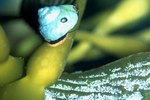
The plecocostomus or pleco is actually a type of algae eater, or more accurately a family of algae-eaters. The term algae eater refers to any aquarium organism that eats algae, which can help you keep on top of algae. Both freshwater and marine aquariums feature a number of diverse algae-eaters. However, you cannot count on algae-eaters to take over all of your cleaning duties; you still need to keep up on water changes and your other maintenance.
Possible Plecos
The common plecostomus or pleco (Hypostomus plecostomus) often gets sold as an algae eater. While the fish does enthusiastically eat algae, he does not make the best choice for most aquariums, since he can grow longer than a foot. However, other species of pleco stay smaller. Both the busynose and rubernose plecos stay under 6 inches and include several differently colored species. Additionally, the dwarf pleco (Otocinclus spp.) never grows larger than an inch and a half. The zebra pleco (Hypancistrus zebra or L46) stays small and is gorgeous but is one of the few plecos that doesn't eat much algae.
Alternate Algae Eaters
Outside of the plecos, you have a plethora of other algae eater options. The flying fox (Epalzeorhynchos kalopterus) and the Siamese algae eater (Crossocheilus siamensis) both stay under 4 inches and will help control algae. Additionally, many cichlids and livebearers will also nibble on algae. However, avoid the Chinese algae eater (Gyrinocheilus aymonieri). This fish does not come from China or eat much algae. It grows to about 10 inches and may attack other fish.
Saltwater Algae Eaters
On the saltwater side of the aquarium hobby, you have a diverse range of algae-eating options. Blennies, dwarf angelfish and tangs/surgeonfish will all continuously graze on algae, helping to keep algae in check. However, always research the species in question before adding it to your aquarium. Some great algae eaters will also enthusiastically eat expensive corals and other invertebrates. In aquarium literature, a species that will not harm coral will be listed as "reef safe." Always check for this when selecting a saltwater algae eater.
Inveterate Invertebrate Algae Eaters
In both freshwater and saltwater aquariums, invertebrates like crustaceans and snails can also help control algae. Snails like mystery snails and shrimp like the Amano shrimp enthusiastically graze for algae just like some fish do. Saltwater pet shops will often sell "cleanup crews" -- assorted invertebrates that will eat algae, sift sand and eat any other detritus to maintain the aquarium. However, with invertebrates, you need to keep two things in mind: First, many species of snail can breed exponentially if they have enough food, overrunning a tank. Additionally, some less-than-scrupulous dealers will sell cleanup crews that are just random grab-bags of small invertebrates, which might not do much for algae and may actually harm fish or desirable invertebrates.
References
Photo Credits
-
Medioimages/Photodisc/Valueline/Getty Images




